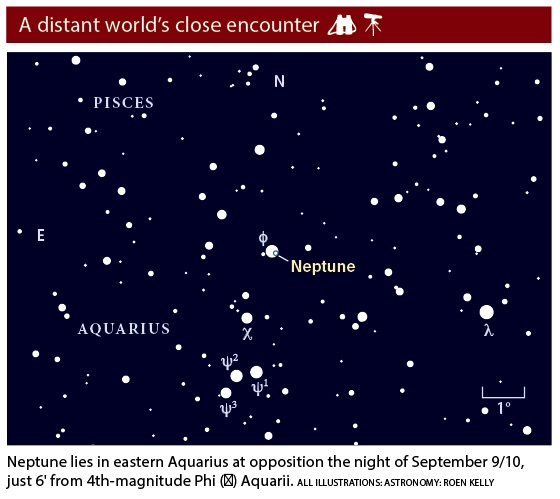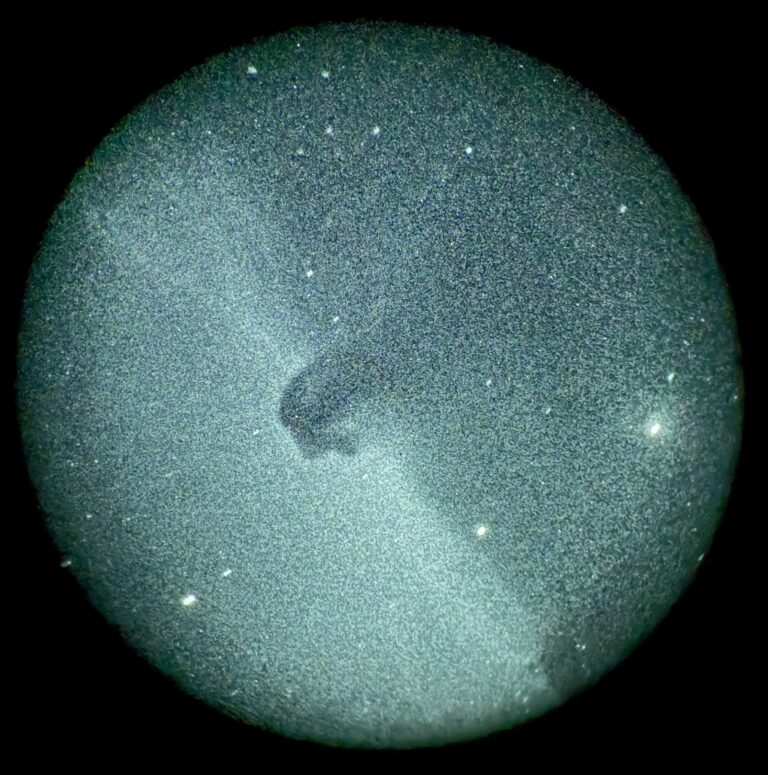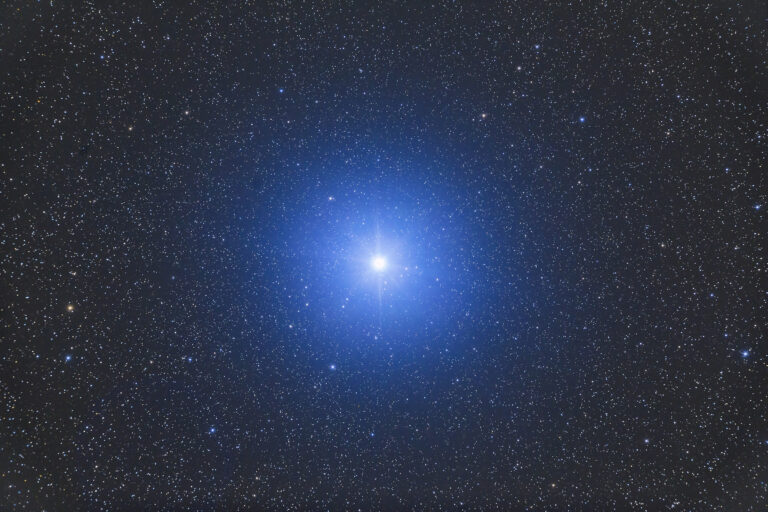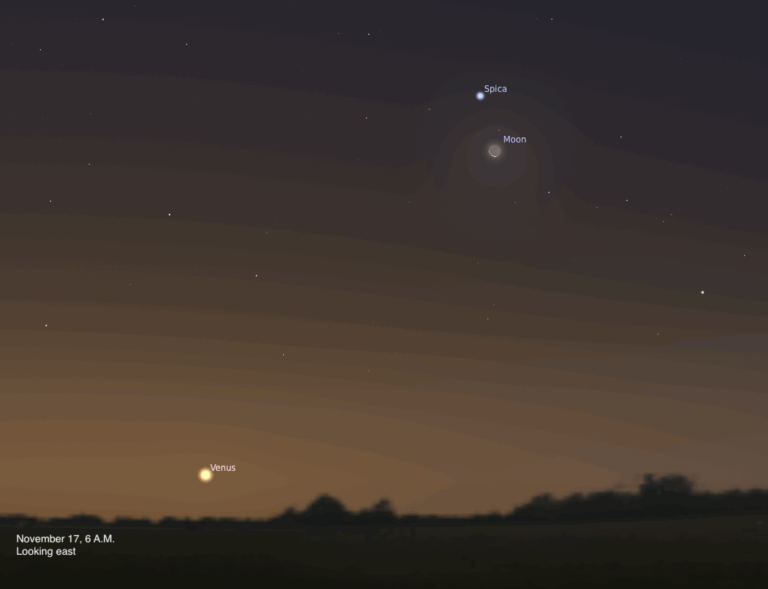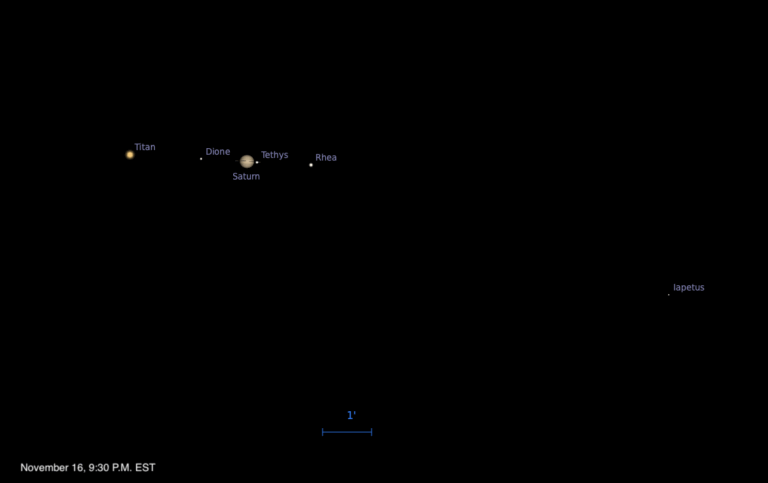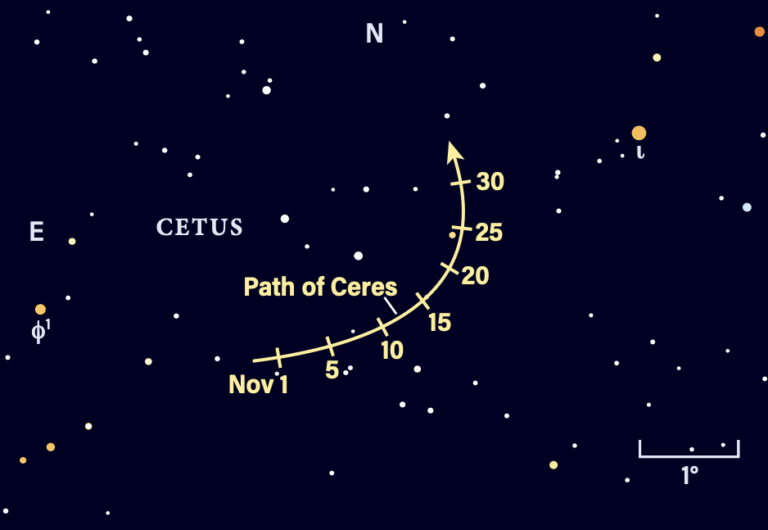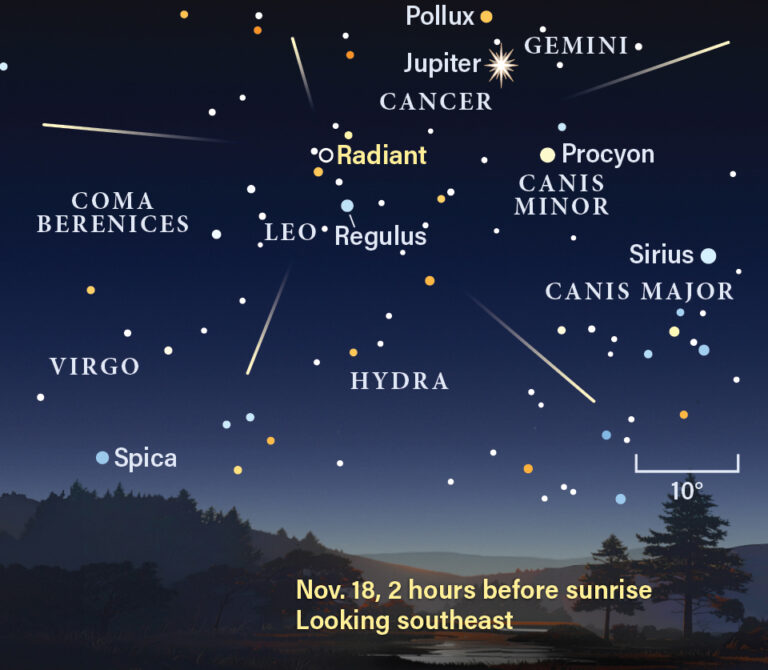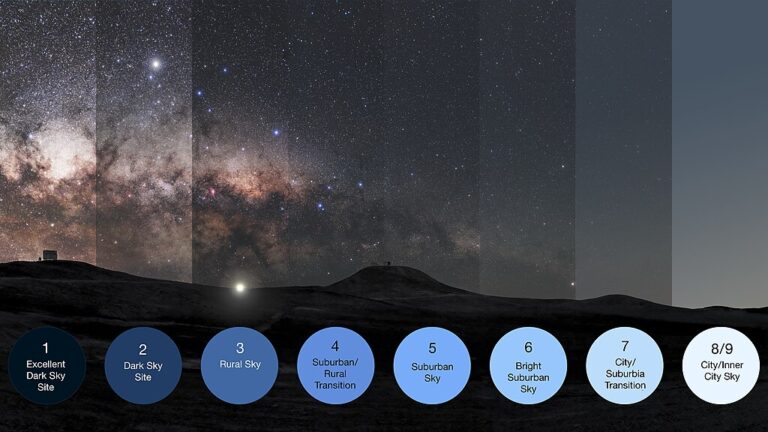Key Takeaways:
Let’s start our tour in the evening sky with the toughest targets. Both Mercury and Venus make fleeting appearances in bright twilight as September draws to a close. On the 30th, Venus stands 1° above the western horizon 30 minutes after sunset. Gleaming at magnitude –3.9, it shows up only because it shines so brightly. You might see magnitude –0.2 Mercury one binocular field to Venus’ upper left.
The inner planets fare poorly because the ecliptic — the path of the Sun and planets across the sky — makes a shallow angle to the western horizon after sunset from mid-northern latitudes. Thus, the angular separation of a planet from the Sun translates mostly into distance along the horizon and not into altitude.
You won’t have to strain at all to see Jupiter. The giant planet shines brilliantly in southern Ophiuchus. It stands 25° high in the south-southwest an hour after sunset in early September and 20° high in the southwest at the same time as the month closes. During the same period, Jupiter fades from magnitude –2.2 to –2.0. This makes the planet some 20 times brighter than Antares, the red supergiant star that lies 8° to Jupiter’s lower right. The First Quarter Moon stands 4° to Jupiter’s right and 7° above Antares on September 5.
Jupiter appears best through a telescope starting in late twilight, when the planet is high enough to avoid the poor seeing conditions that typically interfere with objects near the horizon. This gives you a couple of hours of prime observing in early September and at least an hour of good views as the month winds down.
Lower-contrast details pop into view along the edges of the equatorial belts during moments of steady seeing. Jupiter’s fast spin drives these features. The giant planet’s equatorial regions rotate once every 9 hours 50 minutes, taking five minutes less than at higher latitudes.
Any telescope also reveals Jupiter’s four bright moons. All four typically show up against the blackness of space near the planet, but occasionally one or more hides in plain sight as it crosses in front of the planet. Watching these transits, and the far easier shadow transits that follow close on their heels, can be a riveting experience.
With Jupiter on display for only a few hours each evening, however, only a limited number of events are visible. Your first good look comes September 4, when Io transits Jupiter. The innermost moon first touches the planet’s limb at 8:04 p.m. EDT, and its shadow follows at 9:21 p.m. Both moon and shadow take about 130 minutes to transit the jovian disk.
Giant Ganymede’s shadow crosses Jupiter’s north polar region starting at 11:22 p.m. EDT on September 5. Although the gas giant is setting along the East Coast, observers farther west will get nice views of the shadow’s 153-minute transit.
Jupiter’s four bright moons all orbit in the planet’s equatorial plane, so they usually line up. But this symmetry breaks down once in a while. Watch the evening of September 19, and you’ll see Ganymede pass 30″ due north of Callisto.
Saturn lies 30° east of Jupiter and trails some two hours behind its sister world. This lag is great news for Saturn watchers because it places the planet at its highest in the south as darkness falls and keeps it on view past midnight. Saturn lies in Sagittarius, just south of the constellation’s Teaspoon asterism. The magnitude 0.4 ringed world shines nearly four times brighter than any of the Archer’s stars.
The large tilt of the rings provides exquisite views of their structure. Any scope shows the outer A ring, the brighter B ring, and the dark Cassini Division that separates the two. The ghostly C ring lies closest to Saturn and appears through larger instruments under good viewing conditions.
Amateur telescopes also reveal six saturnian moons. The brightest, 8th-magnitude Titan, shows up through any scope. It takes 16 days to complete an orbit; you can find it due south of Saturn on September 7 and 23 and due north of the planet September 16.
Three 10th-magnitude moons — Tethys, Dione, and Rhea — orbit closer to Saturn than Titan and appear through 4-inch and larger scopes. You’ll need a bigger instrument to see 12th-magnitude Enceladus. This satellite orbits so close to the rings’ outer edge that it is often lost in the glare. Look for it September 4 when it lies 5″ southwest of Tethys.
Iapetus brightens and fades as it orbits Saturn because it has one bright and one dark hemisphere that turn toward Earth in phase with its orbit. It glows at 11th magnitude when it passes 1.4′ south of Saturn on September 11. It brightens as it heads west in the following weeks, reaching 10th magnitude when it lies 8.5′ from the planet at the end of the month.
You’ll need binoculars or a telescope to capture the fainter glow of magnitude 7.8 Neptune. First, locate Phi in eastern Aquarius. The star appears 30° high in the southeast by 11 p.m. local daylight time on the 1st and reaches a similar altitude by 9 p.m. at month’s end.
Once you have Phi in focus, Neptune will be in the same low-power field. The planet lies 7′ east of the star September 1, but the gap closes with each passing night. At 11 p.m. EDT on the 5th, Neptune stands 42″ east of Phi, and the separation narrows by about 4″ with each passing hour. They come closest — 13″ apart — shortly after daybreak on the 6th. The two make a lovely contrast all night, with Phi a ruddy point of light and blue-gray Neptune showing a 2.4″-diameter disk.
Neptune’s westward motion carries it 6′ west of Phi at opposition and 40′ away by the end of September. Still, the two appear within the same low-power field.
Although magnitude 5.7 Uranus shines significantly brighter than Neptune, it’s harder to find because it lacks a nearby star to guide you. Uranus rises among the background stars of southern Aries by 10 p.m. local daylight time in early September and two hours earlier by month’s end, though it proves much easier to find once it climbs high in the south after midnight.
To locate Uranus, start at 2nd-magnitude Hamal (Alpha [α] Arietis), the Ram’s brightest star. The planet lies 11° south of Hamal in a sparse region slightly south of 6th-magnitude 19 Ari. Uranus appears less than 2.5° south of this star throughout September. To verify your planet sighting, target the object with a telescope; only Uranus shows a blue-green disk that spans 3.7″.
Mars is too close to the Sun to see. It will return to view before dawn in late October.
RISING MOON: A terrific trio of terraced craters
The waxing crescent Moon offers a smorgasbord of fantastic views. From the slenderest of arcs to First Quarter phase, Luna shows off rolling seas bordered by craters with towering peaks and aprons of debris blasted out during the impacts that created them. The best detail appears along the terminator, where the Sun is rising and encroaches on the dark lunar night.
Let’s focus on the scene the evening of September 4. If you look just south of the lunar equator, three magnificent craters will grab your attention. Northernmost Theophilus has the most classic shape of the trio: It showcases a sharp, almost perfectly circular rim with a dramatic multiple peak at its center. Because it is much bigger and deeper than the crater Mädler immediately to its east, Theophilus’ walls have slumped into terraces that appear most noticeable on its western flank.
You can make some educated guesses as to the relative ages of lunar features even without the tools of a geologist. Theophilus must be younger than neighboring Cyrillus to the southwest because it overlays the latter crater’s ragged rim. Although Cyrillus also has a complex peak and slumped walls, the impacts of smaller objects over the ages have degraded them. Also note that the debris apron surrounding Theophilus partially fills Cyrillus. The apron’s rough texture is obvious at this phase. Under a high Sun at Full Moon, this topographic detail vanishes. Mädler seems to shelter the terrain to its east from this debris, hinting at its intermediate age.
The southernmost member of the crater trio is Catharina. Once upon a time, it must have been sharp-featured like Theophilus, but billions of years of bombardment have erased the central peak and left its walls lower and softer.
METEOR WATCH: Catch the false dawn
The ecliptic’s low angle to the western horizon after sunset, which keeps Mercury and Venus immersed in bright twilight all month, has a favorable flip side — the ecliptic stands nearly straight up from the eastern horizon before sunrise. This solar system geometry affords observers great views of the false dawn, or zodiacal light, on September mornings.
This faint, cone-shaped glow has a broad base in Leo and tapers as it climbs through Cancer and Gemini into Taurus. The glow arises from sunlight reflecting off fine dust particles in the plane of the solar system, which is why it aligns with the ecliptic. To see the light, you need to observe from a dark site shortly before twilight begins. Catch the false dawn’s ethereal glow on moonless mornings, which run from September 27 to October 11 this year.
After a seemingly endless string of months without a decent comet, the tide starts to turn in September. Comet Africano (C/2018 W2) gets us started as it brightens to 9th magnitude this month.
Africano does need time to flourish, however. Our first taste of the comet comes in early September, when it glows at 11th magnitude against the backdrop of Perseus. It remains visible all night, climbing nearly overhead shortly before dawn.
The comet grows brighter and more intriguing when it comes closest to Earth at New Moon in September’s final week. Our planet passes through the comet’s orbital plane on the 24th. To see why this matters, imagine a comet’s picture etched into a glass door, and look at it as you walk past the door edge-on. The comet’s curved dust tail appears as a thin knife to the north while its southern flank sports a short anti-tail. It seems to poke out the other side simply because we see it from below.
On September 28, Africano shares the same low-power field as the 11th-magnitude spiral galaxy NGC 7743 in southern Pegasus. Both objects should be brighter in the middle, but their shapes will be quite different. The galaxy appears nicely symmetric, while the comet looks more angular and shows a sharper southern edge. Use as much power as the objects can take in order to see these details more clearly.
Astronomers Brian Africano and Hannes Groeller discovered this comet within minutes of each other November 27, 2018. It’s moving in the opposite direction from Earth’s orbital motion, which causes it to zip across nearly 70° of sky this month. Its hyperbolic trajectory suggests it might have originated outside the solar system, but it could just as easily have received a boost from another Oort Cloud comet long ago.
Even if you’re stuck in the suburbs, you’ll be able to spot a 9th-magnitude dwarf planet through a 3-inch telescope this month. Ceres has faded some since its late May peak, so it will be a challenge to see through binoculars. Several bright stars in the vicinity make the hunt easier, however, so it’s a good time to take another look at Ceres.
The dwarf planet lies near 1st-magnitude Antares, the ruddy supergiant that marks the heart of Scorpius the Scorpion. More importantly, the darkness behind Ceres helps it stand out. In August, Ceres floated in front of fields swarming with stars belonging to the Milky Way’s central bulge. But in September, it traverses star-poor dust lanes. What makes the journey even better for imagers are the super-photogenic swaths of red, blue, and yellow clouds of gas and dust that form the Rho (ρ) Ophiuchi complex.
On September 15, Ceres passes 2.9° north of Antares, and the closest star that outshines the asteroid lies 1° away. Identifying Ceres will be easy, but detecting its motion from night to night will be nearly impossible. For that, you need some nice reference stars. The best is Rho Oph itself, which stands 12′ south of Ceres on the 11th, though a few field stars perform admirably on September’s last few evenings. Simply sketch the positions of three or four stars and then add a dot for Ceres as it moves hour by hour.


